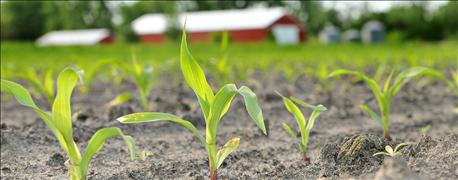
Corn typically requires 90 to 120 Growing Degree Days from planting to emergence. Of course this GDD range assumes adequate soil moisture and varies with planting depth, tillage system and amount of crop residue cover.
As a rule of thumb, if 120 GDD have accumulated since planting and seedlings haven’t emerged, you should check the condition of planted seed ASAP, advises Clarke McGrath, Iowa State University Extension field agronomist. He is also the On-Farm Research and Extension coordinator for the Iowa Soybean Research Center at ISU.

HOW LONG? Lab studies show for most corn hybrids grown in the Midwest, seedling emergence takes about three weeks if soil temperature is 51 degrees F at planting depth. It’s about one week if daily soil temperature holds near 70 degrees.
Watch early-planted fields to see how 2016 corn progressing
“For example, in west-central Iowa we have had an accumulation of around 120 GDDs since April 11,” he advises. Some acres were planted a week prior to that and had just a few more GDDs. Then, a lot of corn went in from April 10 on to April 25. According to the GDD accumulation, much of this early planted corn should be spiking soon.
“So in between rain showers this week would be a good time to take a look at fields and see how the early planted 2016 corn is progressing,” notes McGrath.
You can keep track of GDD accumulations at this website
As soil temperatures get to around 60 degrees F (which was just touched last weekend in western Iowa, at Harlan, where McGrath is located), corn comes up in about 10 days, “which is hopefully where the corn that is planted in the next week or two will end up,” says McGrath.
You can track GDD accumulations for the Corn Belt location of your choice by hitting your fields of choice on the map at this interactive site: mygeohub.org/groups/u2u/gdd. There are also good free apps to track GDDs, check your respective app store to see what you like.
It’s critical to check for corn emergence and seedling health
You need to remember that GDDs are calculated based on air temperatures using the 86/50 method typical for corn production. Using that method, if air temperatures remain at or below 50 degrees, emergence will not occur. “We hope this isn’t a continuing issue now that we are into late April,” says McGrath. “Although our forecast for this week isn’t good for getting corn to emerge; starting Wednesday, April 27 we are projected to get six days in a row of highs in the mid-50s to low 60s and lows in the mid to upper 40s. It will be especially critical to check corn emergence and seedling health after we get through that stretch and corn starts to have significant growth again.”
.jpg?width=200&auto=webp&quality=80&disable=upscale)
HOW FAST? If soil temperature is averaging 50 to 55 degrees F (10 to 12.8 C) at time of planting, corn may take three weeks to emerge. Temperatures averaging 60 degrees (15.6 C), may have emergence in 10 to 12 days. Soybean emergence usually requires that soils be about 10 degrees warmer than for corn although soybean does begin to respond at 50 degrees. This data is from Elwynn Taylor, Iowa State University Extension climatologist.
Since GDD calculations are based on air temperatures, soil temperatures measured at the 4-inch depth may actually better predict seedling emergence than accumulated GDD’s. The Mesonet provides a daily update of both Iowa soil temperature and GDDs, you can find the information at mesonet.agron.iastate.edu/agclimate/#tmpf.
Seedling emergence takes 3 weeks if soil temp is only 51 degrees
Lab studies have shown that for most corn hybrids grown in the Midwest, seedling emergence takes about three weeks if the soil temperature is 51 degrees and it is about one week if the daily soil temperature holds near 70 degrees.
About the Author(s)
You May Also Like




